Our parish was established in 1930, the same year the eight Holy Canadian Martyrs were canonized. Read more about the lives and works of the eight men below.
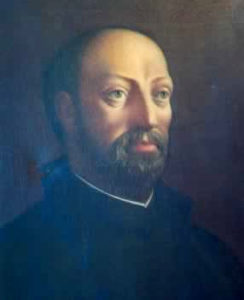 Jean de Brébeuf, S.J. was born March 25, 1593 in Normandy, France and ordained into the priesthood at the age of 33.
Jean de Brébeuf, S.J. was born March 25, 1593 in Normandy, France and ordained into the priesthood at the age of 33.
Fr. de Brébeuf was the first of the Jesuit missionaries in Huronia on the shores of Georgian Bay, arriving in 1626. He was a large man, very strong, yet gentle in character. He worked throughout Huronia for 20 years, becoming a master of the native languages and learning the local native customs and practices, so as to develop the best approach to teaching them about Christ. He established mission outposts and taught the Jesuit newcomers the native languages so that they too could teach the Word. He is credited with writing the first dictionary of the Huron language.
While respectful of the mighty “Echon” (meaning ‘he who carries heavy load’), the most powerful of the Black Robes (a term referring to Fr. de Brébeuf’s daily dress), the Hurons were a superstitious people. They allowed only their dying children and infirmed adults to be baptized. In 1640, when they had suffered from drought and illness for several years, they decided it must be because of the Black Robes, and they began to harass the missions and the missionaries.
As a young priest, Fr. de Brébeuf had made a vow never to refuse the offer of martyrdom if asked to die for Christ. By 1649, the possibility of martyrdom was ever more present. Although now an important ally of the Hurons and known as the “Apostle of the Hurons,” he and fellow Jesuit, Gabriel Lalemant, were captured by the warring Mohawk, bound to a cross and tortured for hours. With incredible courage, he continued to encourage the Christian Hurons who were suffering with him to endure the pain in return for everlasting Heaven. He was martyred on March 16, 1649 at St. Ignace at the age of 56.
On June 21, 1925, Pope Pius XI beatified Fr. Jean de Brébeuf. His canonization took place on June 29, 1930 and his feast is celebrated on October 19 in the United States and September 26 in Canada.
Sources:
- Joseph N. Tylenda, S.J. Jesuit Saints and Martyrs. Chicago: Loyola University Press, 1984
- Celebrate Jesuit! The Canadian Jesuits Turn 40, 1611-2011. Toronto: The Jesuits in English Canada, 2011.
- “Jesuits in Canada: 400 Years of Service,” Catholic Register, special insert September 18, 2011.
- Triumph of the Cross, Jesuit Martyrs and Shrines. Strasboug, France: Editions du Signe, 1990.
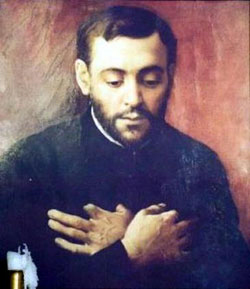 Isaac Jogues, S.J. was born January 10, 1607 in France. He was 29 when he set out for Canada and the missions of Huronia, and he had been a priest for just seven months.
Isaac Jogues, S.J. was born January 10, 1607 in France. He was 29 when he set out for Canada and the missions of Huronia, and he had been a priest for just seven months.
Fr. Jogues arrived in Huronia in 1636 and spent three years serving mission outposts, instructing and baptizing. He lived with the Hurons in Sainte-Marie, a flourishing village. Though happy and successful in Sainte-Marie, he desired more of a challenge, and prayed that he could have the opportunity to undergo any hardship so as to implant faith in the native people of Huronia.
Fr. Jogues’ prayers were answered. The Iroquois Nation was again at war with the French and on a journey from Quebec City in 1642, he was captured by the Mohawk tribe, brutally tortured and made a slave. He lived with the Mohawks for 13 months, during which time he ministered to the Christian Hurons who had been captured with him.
Fr. Jogues returned to France a hero and was referred to as the “living martyr”. Given dispensation by Pope Urban VII, Isaac was able to say mass in spite of his mutilated hands. His stay in France was not long as he yearned for missionary work. He returned to Canada the very next year, sent by the French government to discuss a peace treaty with the Indian nations.
The members of the Mohawk tribe to whom he had been a slave were surprised to see Fr. Jogues now dressed as an ambassador of a powerful nation. He was successful at getting many of the warring Indian tibes to sign peace treaties with France and he wanted to go back to the Mohawks as a missionary. However, by 1646, the Mohawks were on the war path again and while journeying through Indian land, he was captured and cruelly beaten. A tomahawk blow to the head killed him on October 18, at the age of 39.
On June 21, 1925, Pope Pius XI beatified Fr. Isaac Jogues. His canonization took place on June 29, 1930 and his feast is celebrated on October 19 in the United States and on September 26 in Canada. Saint Isaac is also known as the patron saint of diplomats, having returned to the Mohawk people on a mission of peace.
Sources:
- Joseph N. Tylenda, S.J. Jesuit Saints and Martyrs. Chicago: Loyola University Press, 1984.
- Celebrate Jesuit! The Canadian Jesuits Turn 40, 1611-2011. Toronto: The Jesuits in English Canada, 2011.
- “Jesuits in Canada: 400 Years of Service,” Catholic Register, special insert September 18, 2011
- Triumph of the Cross, Jesuit Martyrs and Shrines. Strasboug, France: Editions du Signe, 1990.
- Martyrs and Shrines. Strasboug, France: Editions du Signe, 1990.
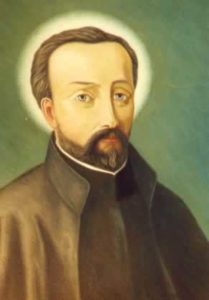 Gabriel Lalemant, S.J. was born in Paris, France on October 10, 1610. He became a Jesuit at age 19 and was a scholar of philosophy and dean of studies in French colleges. Though of delicate health, it was his ambition to work in foreign missions and he requested repeatedly to be sent to the Canadian missions as his uncles had before him.
Gabriel Lalemant, S.J. was born in Paris, France on October 10, 1610. He became a Jesuit at age 19 and was a scholar of philosophy and dean of studies in French colleges. Though of delicate health, it was his ambition to work in foreign missions and he requested repeatedly to be sent to the Canadian missions as his uncles had before him.
At long last, Fr. Lalemant arrived in Huronia in September 1648 and began to work with the native people, quickly learning the local cultures and language. He was sent to work with Fr. de Brébeuf early the next year, an adventure to which he greatly looked forward.
Just one month later, the Mohawk attacked the town were Fr. Lalemant and Fr. de Brébeuf were working. The two Jesuits had just enough time to slip away and travel to a nearby settlement to warn the next group of Hurons that the Mohawk were “on the warpath.” They helped send the women and children into the woods, prepare the men for battle and the Jesuits baptized, confessed and absolved the Christians in the settlement.
Fr. Lalemant and Fr. de Brébeuf were both captured, tied to crosses and tortured at the hands of the warring Mohawk. Fr. Lalemant, though more delicate than Fr. de Brébeuf, was required to witness the martyrdom of his fellow Jesuit. Throughout his ordeal, Fr. Lalemant’s prayer was simple: “Jesus, have mercy on us!” After just six months in Huronia, Fr. Lalemant died on March 17, 1649 at St. Ignace at the age of 39.
On June 21, 1925, Pope Pius XI beatified Fr. Gabriel Lalemant. His canonization took place on June 29, 1930 and his feast is celebrated on October 19 in the United States and on September 26 in Canada.
Sources:
- Joseph N. Tylenda, S.J. Jesuit Saints and Martyrs. Chicago: Loyola University Press, 1984.
- Celebrate Jesuit! The Canadian Jesuits Turn 40, 1611-2011. Toronto: The Jesuits in English Canada, 2011
- “Jesuits in Canada: 400 Years of Service,” Catholic Register, special insert September 18, 2011.
- Triumph of the Cross, Jesuit Martyrs and Shrines. Strasboug, France: Editions du Signe, 1990.
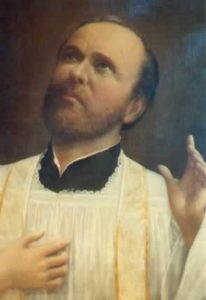 Antoine Daniel, S.J. was born in Dieppe, France on May 27, 1601, became a Jesuit and was ordained a priest in 1631 at age 29.
Antoine Daniel, S.J. was born in Dieppe, France on May 27, 1601, became a Jesuit and was ordained a priest in 1631 at age 29.
Even before he was a priest, Antoine met a Huron youth, sent to France to study. The idea of being a part of the conversion of the Hurons to Christianity inspired Antoine. Finally, the opportunity to answer this call to the missions in Canada was provided and, as a priest, he was sent in 1632 to Cape Breton Island and Quebec, one year later, where he worked near Bras d’Or Lakes.
Fr. Daniel worked with Fr. de Brébeuf and found that he had a gift for teaching children; he set to music the new prayers and commandments from the Word of Christ. He founded the first boy’s college in North America in Quebec in 1635; despite his efforts, the Hurons were not ready for the European school system and the college was closed two years later.
Fr. Daniel worked in Huronia for 12 years. During this time, Fr. Daniel mastered the language and dreamed of developing future catechists from among the Hurons with whom he worked. Unfortunately he found himself in a village on the “warpath” of the Mohawk. The mission was attacked by the warring Mohawk in the summer of 1648. Fr. Daniel quickly finished saying the mass of that day, baptizing and absolving as many of the faithful as he could. Many of the villagers sought refuge in the church, so Fr. Daniel set himself outside the building with a cross as a diversion, demanding the Mohawk to leave the village. The warriors ignored Fr. Daniel’s resistance and burned the building. Fr. Daniel was killed by the bullets and arrows of the Mohawk on July 4, 1648. His body was thrown into the burning church so he could die for his shepherd, Christ, with “his sheep”.
On June 21, 1925, Pope Pius XI beatified Fr. Antoine Daniel. His canonization took place on June 29, 1930 and his feast is celebrated on October 19 in the United States and on September 26 in Canada.
Sources:
- Joseph N. Tylenda, S.J. Jesuit Saints and Martyrs. Chicago: Loyola University Press, 1984.
- Celebrate Jesuit! The Canadian Jesuits Turn 40, 1611-2011. Toronto: The Jesuits in English Canada, 2011.
- “Jesuits in Canada: 400 Years of Service,” Catholic Register, special insert September 18, 2011.
- Triumph of the Cross, Jesuit Martyrs and Shrines. Strasboug, France: Editions du Signe, 1990.
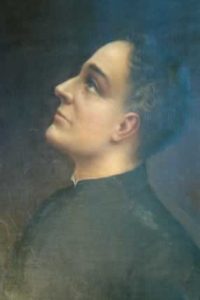 Charles Garnier, S.J. was born on May 26, 1606 in Paris to a wealthy family with a place in Henry III’s household. He entered the Jesuit novitiate in 1624 at 18 years of age and was ordained in 1635. He was attracted to the hard life of a missionary in Canada. He was a person of innocence and purity, with a strong devotion to Our Lady, whom he acknowledged looked after him as a youth.
Charles Garnier, S.J. was born on May 26, 1606 in Paris to a wealthy family with a place in Henry III’s household. He entered the Jesuit novitiate in 1624 at 18 years of age and was ordained in 1635. He was attracted to the hard life of a missionary in Canada. He was a person of innocence and purity, with a strong devotion to Our Lady, whom he acknowledged looked after him as a youth.
Fr. Garnier came to Huronia in 1636, at the age of 31, with Fr. Jogues and proceeded to work with Fr. de Brébeuf, learning the language and customs of the Huron. His quiet disposition did not create much space for him in the history books, however he is known as the “lamb” to Fr. de Brébeuf’s “lion”.
During the 13 years in Canada, Fr. Garnier went from working with the Hurons to working with the neighboring Petuns, a slightly more hostile group. His quiet way was well-suited for this more reserved group of native peoples. He built two chapels and baptized some 184 natives among the Petun people.
In 1649, there were rumours of Mohawk warriors ravaging the nearby villages. Fr. Garnier sent Fr. Noël Chabanel, his assistant, back to relative safety in Quebec and continued ministry on his own. He was captured in an Mohawk massacre of the Petun villages. Hit by an Mohawk bullet, he fell but awoke to absolve a young Petun brave who lay near him. Seeing Fr. Garnier move, an Mohawk warrior used a tomahawk to kill the priest on December 7, 1649.
On June 21, 1925, Pope Pius XI beatified Fr. Charles Garnier. His canonization took place on June 29, 1930 and his feast is celebrated on October 19 in the United States and on September 26 in Canada.
Sources:
- Joseph N. Tylenda, S.J. Jesuit Saints and Martyrs. Chicago: Loyola University Press, 1984.
- Celebrate Jesuit! The Canadian Jesuits Turn 40, 1611-2011. Toronto: The Jesuits in English Canada, 2011.
- “Jesuits in Canada: 400 Years of Service,” Catholic Register, special insert September 18, 2011
- Triumph of the Cross, Jesuit Martyrs and Shrines. Strasboug, France: Editions du Signe, 1990.
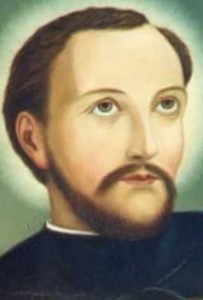
Noël Chabanel, S. J. was born on February 2, 1613 in the south of France to an affluent family. He became a Jesuit at the age of 17, and a priest at 28. He was a successful professor in France.
With a strong desire to experience the missionary way of life, Fr. Chabanel traveled to the Canadian missions in 1643. After a year in the safety of Quebec, away from the raging Mohawk warriors, he joined Fr. de Brébeuf and colleagues and travelled out to the missions of Huronia. His enthusiasm quickly faded when he was not able to master the language and didn’t care for the surroundings and customs of the Indians with whom he lived and worked. He made reference to his time in Huronia as “bloodless martyrdom”. Though Fr. Chabanel was urged by his superiors in the missions to return to France, he bound himself to a vow to stay in Huronia until death.
Fr. Chabanel was the last of the Canadian martyrs to meet his death. He was slain by a Huron on December 8, 1649, near the village of Ste. Marie. He was 36 years old. He was the only martyr killed by one of the Hurons who had worked with the Jesuits in Canada.
On June 21, 1925, Pope Pius XI beatified Fr. Noël Chabanel. His canonization took place on June 29, 1930 and his feast is celebrated on October 19 in the United States and on September 26 in Canada.
Sources:
- Joseph N. Tylenda, S.J. Jesuit Saints and Martyrs. Chicago: Loyola University Press, 1984.
- Celebrate Jesuit! The Canadian Jesuits Turn 40, 1611-2011. Toronto: The Jesuits in English Canada, 2011.
- “Jesuits in Canada: 400 Years of Service,” Catholic Register, special insert September 18, 2011.
- Triumph of the Cross, Jesuit Martyrs and Shrines. Strasboug, France: Editions du Signe, 1990.
 René Goupil was born in 1608 in the south of France and joined the Jesuit Order in Paris. He was not able to complete his studies with the Society of Jesus because he was deaf and suffering from ill health. He studied medicine and though he had a successful career, he truly wanted to offer his skills to the Jesuit missionaries in the missions in Canada.
René Goupil was born in 1608 in the south of France and joined the Jesuit Order in Paris. He was not able to complete his studies with the Society of Jesus because he was deaf and suffering from ill health. He studied medicine and though he had a successful career, he truly wanted to offer his skills to the Jesuit missionaries in the missions in Canada.
René Goupil travelled to Canada and was at first posted in Quebec in 1640 to care for the villagers and Algonquin villages nearby. His chance to work with the native people more intimately came two years later when he accompanied Fr. Isaac Jogues to Huron country. On the way, they were captured by the Mohawks and taken to be slaves in Mohawk country. A comfort to one another and with the uncertain future that lay ahead, Goupil took this occasion to ask Fr. Jogues to receive his vows as a priest. Goupil remembered the vow formula from his days as a novice and pronounced his vows to become a Brother to Fr. Jogues.
One month later, Br. Goupil was playing with children in the village and lead one child in making the sign of the cross. Within the day, he was ambushed and killed with a tomahawk by the child’s uncle for this act. He was the first of the Canadian martyrs to be killed on September 29 at the age of 35. Br. René Goupil is the patron saint for the deaf-mute.
On June 21, 1925, Pope Pius XI beatified Br. René Goupil. His canonization took place on June 29, 1930 and his feast is celebrated on October 19 in the United States and on September 26 in Canada.
Sources:
- Joseph N. Tylenda, S.J. Jesuit Saints and Martyrs. Chicago: Loyola University Press, 1984.
- Celebrate Jesuit! The Canadian Jesuits Turn 40, 1611-2011. Toronto: The Jesuits in English Canada, 2011.
- “Jesuits in Canada: 400 Years of Service,” Catholic Register, special insert September 18, 2011.
- Triumph of the Cross, Jesuit Martyrs and Shrines. Strasboug, France: Editions du Signe, 1990.
 Jean de la Lande was born in Dieppe and, as a young man of 17, offered his services to the Jesuit of New France.
Jean de la Lande was born in Dieppe and, as a young man of 17, offered his services to the Jesuit of New France.
He was assigned to Fr. Isaac Jogues as an assistant and accompanied Fr. Jogues to the Mohawk mission on a peace mission in 1646. de la Lande looked to God to protect him and to be his reward if the sacrifice of life was demanded.
The peace party was met with animosity. Jean de la Lande was tortured and threatened with death by the Mohawks as were the Jesuits. On hearing of Fr. Jogues’ death at the hand of the Mohawks, he set out under cover of darkness to find the body to be able to bury it properly. He was ambushed by Mohawk braves and killed on October 19, 1646.
Jean de la Lande is the first and only layman to be canonized.
On June 21, 1925, Pope Pius XI beatified Jean de la Lande. His canonization took place on June 29, 1930 and his feast is celebrated on October 19 in the United States and on September 26 in Canada.
Sources:
- Joseph N. Tylenda, S.J. Jesuit Saints and Martyrs. Chicago: Loyola University Press, 1984.
- Celebrate Jesuit! The Canadian Jesuits Turn 40, 1611-2011. Toronto: The Jesuits in English Canada, 2011.
- “Jesuits in Canada: 400 Years of Service,” Catholic Register, special insert September 18, 2011.
- Triumph of the Cross, Jesuit Martyrs and Shrines. Strasboug, France: Editions du Signe, 1990.
Written by McE Galbreath
*S.J. is short for Society of Jesus, indicating membership in the Jesuit religious order.
